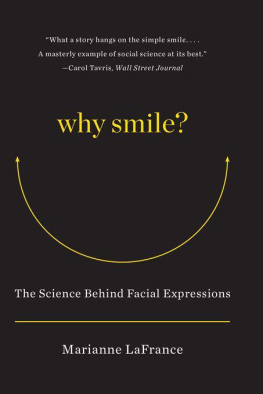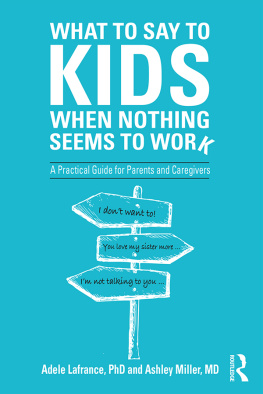WHY
Smile?
The science behind facial expressions
MARIANNE LaFRANCE

W. W. Norton & Company
New York London
Copyright 2011 by Marianne LaFrance
Originally published under title Lip Service: Smiles in Life, Death, Trust, Lies, Work, Memory, Sex, and Politics
First published as a Norton paperback 2013
All rights reserved
Printed in the United States of America
Excerpt from Red Roses for Bronze By H.D. (Hilda Doolittle), from Collected Poems, 19121944 , copyright 1982 by the Estate of Hilda Doolittle. Reprinted by permission of New Directions Publishing Corp. Excerpt from People Take Pictures of Each Other by The Kinks. Used by permission of Alfred Music Publishing Co., Inc.
Photograph creditsp. 6: Megan Mangum; p. 8: Megan Mangum; p. 9: Megan Mangum; p. 15: Megan Mangum, adapted from an illustration by Peter Ratner, author of 3-D Human Modeling and Animation ; p. 16: Megan Mangum; p. 17: McNamee/Corbis; p. 29: copyright 2009, Oxford University Press; p. 35: Peter Turnley / Corbis; p. 39: from D. Messinger, Positive and Negative: Infant Facial Expressions and Emotions, Current Directions in Psychological Science 11 (2002): 16, reprinted by permission of SAGE Publications; p. 40: Michel Bussy / PhotoAlto / Corbis; p. 66: AP Photo / Carlo Allegri; p. 74: Megan Mangum; p. 78: Ramin Talaie / Corbis; p. 81: AP Photo / Nick UT; p. 105: Getty Images; p. 129: David Turnley / Corbis; p. 134: Larry Downing / Sygma / Corbis; p. 139: from Parr, Waller, and Fugate, Emotional Communication in Primates: Implications for Neurobiology, Current Opinion in Neurobiology 15 (2005): 71620; p. 141: Bettmann/Corbis; p. 152: Stefanie Grewel / Corbis; p. 157: Holmes/Corbis; p. 169: courtesy Archives of Michigan; p. 174: Creasource/Corbis; p. 183: AP Photo / Annie Higbee; p. 197: Robert Eric / Corbis Sygma; p. 204: AP Photo / Carl de Souza; p. 220: Megan Mangum; p. 227: Peter Turnley / Corbis; p. 232: Kate Mitchell / Corbis;.p. 243: used by permission of Renso Dionigi, Mikey Siegel, MIT Media Lab.
For information about permission to reproduce selections from this book,
write to Permissions, W. W. Norton & Company, Inc.,
500 Fifth Avenue, New York, NY 10110
For information about special discounts for bulk purchases, please contact
W. W. Norton Special Sales at specialsales@wwnorton.com or 800-233-4830
Manufacturing by Courier Westford
Book design by Chris Welch Design
Production manager: Julia Druskin
Library of Congress Cataloging-in-Publication Data
LaFrance, Marianne, 1947
[Lip service]
Why smile? : the science behind facial expressions / Marianne LaFrance.
p. cm.
Originally published under the title Lip Service: Smiles in Life, Death, Trust, Lies, Work, Memory, Sex, and Politics.
Includes bibliographical references and index.
ISBN 978-0-393-34422-6 (pbk.)
1. Smiling. 2. Nonverbal communication. 3. Body language. I. Title.
BF637.N66L34 2013
153.69dc23
2012037667
W. W. Norton & Company, Inc.
500 Fifth Avenue, New York, N.Y. 10110
www.wwnorton.com
W. W. Norton & Company Ltd.
Castle House, 75/76 Wells Street, London W1T 3QT
1 2 3 4 5 6 7 8 9 0
To Megan, of course
contents
introduction
Brides do it; teasers do it; even educated geezers do it. You and I do it; we all share smiles. Salespeople, infants, politicians, and flirts, sadists and celebrities and children hoping for adoptive homes, they grin and smirk and put on a happy face. The anxious, the eager, the embarrassed... There is no one who has not smiled at least once, although some adhere to W. C. Fieldss advice to start every day with a smile and get it over with.
Smiles are universally recognized and understood for what they show and convey, yet not necessarily for what they do . Smiles are much more than cheerful expressions. They are social acts with consequences. A special someone raises the corners of his mouth in a certain way, and your heart flutters wildly. A competitor or foe shoots you a grin and you find yourself smiling back against your will. In some instances, a smile can save lives: Early in the Iraq War, before the fall of Bagdad, the U.S. Armys 3rd Infantry entered the town of Najaf. As the soldiers marched toward the mosque, agitated residents began to congregate. The responded to the mounting tension by ordering his troops to point their guns to the ground and smile. In that moment, smilesalongside other gestures of conciliationprevented a possible clash.
While a well-timed lift of the lips might defuse a potentially antagonistic situation, sometimes failing to flash your pearly whites just might land you in a brawl. Indeed, between the scarcity of an individuals smiles and the likelihood that he will be aggressive. In an experiment conducted at a college in Ohio, male undergraduates were assigned to compete in a game against someone they did not know. They were told they could administer an electric shock to their opponent, and set the shock level at whatever intensity they chose. When the game was over, results showed that those who smiled less often at their opponents set higher shock levels.
P art of what makes smiles so powerful, and powerfully consequential, are the multiple ways in which they affect those around us. As social psychologists Craig Smith and Heather Scott cleverly put it, skeletal muscles of the body that are used, not to move ourselves, but to move others.
When someone smiles, the consequences are often positive for the person who receives it: a glum mood lifts; an apology is accepted; a persons shaky self-confidence gets a boost; a deal is struck; the attraction is confirmed as mutual; a contribution is acknowledged; and everyone can now relax.
But change the circumstances or the cast of a smile, and the consequences shift: a rival grins to get under your skin; a bullys smirk unsettles his mark. Manipulators adopt faces to suit their ulterior motives; hypocrites smile at one and all.
When I say that a smile is a social act with consequences, I do not mean that smiling is necessarily intentional, nor do I mean that smilers and their recipients are necessarily conscious of, or have calibrated for, the gestures impact. Just because an infants gummy grin elicits gushing from an adult does not mean that was what the baby intended. But smiling does affect how we relate to each other, something a baby may not know or know how to control, but which is part of how our bodies and brains have evolved to help ensure our survival.
Scientists have observed in the womb, showing recognizable smiles a month or two before birth. They smile involuntarily because they need to have these muscles operational so that they can entice supportive adults. Infants can do nothing for themselvesthey cannot even hold their heads up, let alone feed and fend for themselves. Unless young ones can get others to sustain them, they will die, if not physically then emotionally. They smile for their supper and for other comforts as well. As they develop, they learn to smile deliberately; at the outset, their smiles are involuntary but no less consequential. Its likely their first social manipulation, and yet the act of smiling, in this first form, is unconscious. And unconscious smiling does not end at infancy.
Once, following a talk I gave on facial expressions, a woman from the audience told me about a stretch of time when she was unaware that she was smiling. She worked at a restaurant and smiled as she served customers. On her way home at night she would stop at a twenty-four-hour supermarket, and as she did her shopping, other shoppers would suddenly start talking to her. It took her a while to figure out that she had not stopped smiling since leaving work. Some shoppers took her positive facial expression as a conversational opener.
Next page













